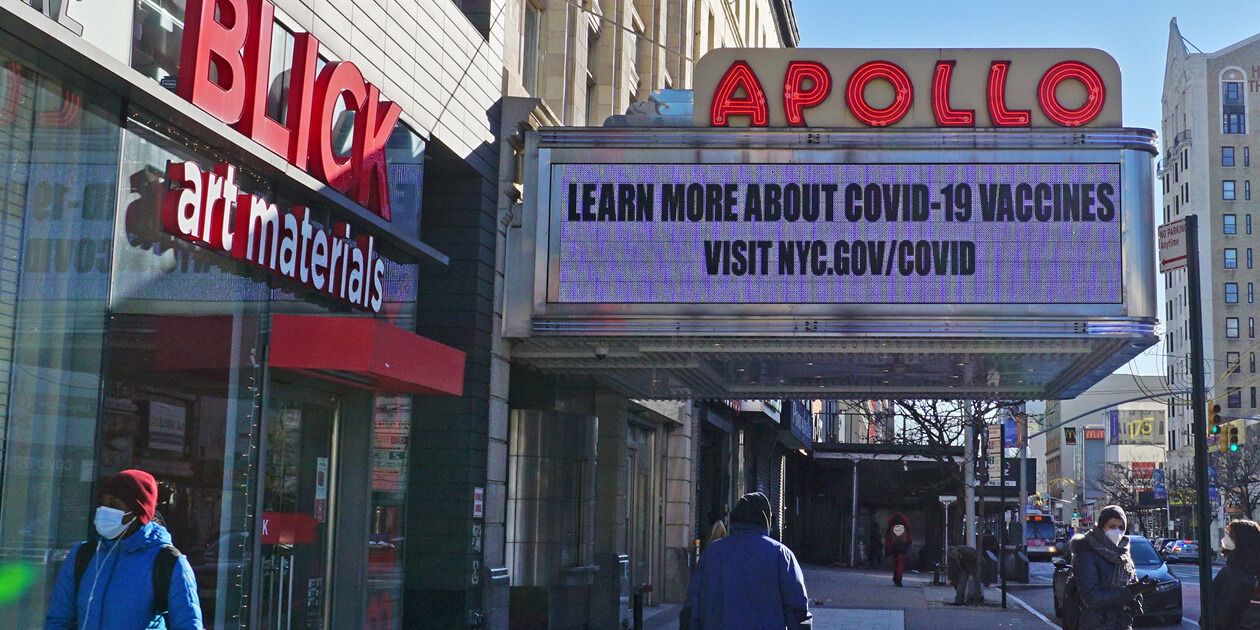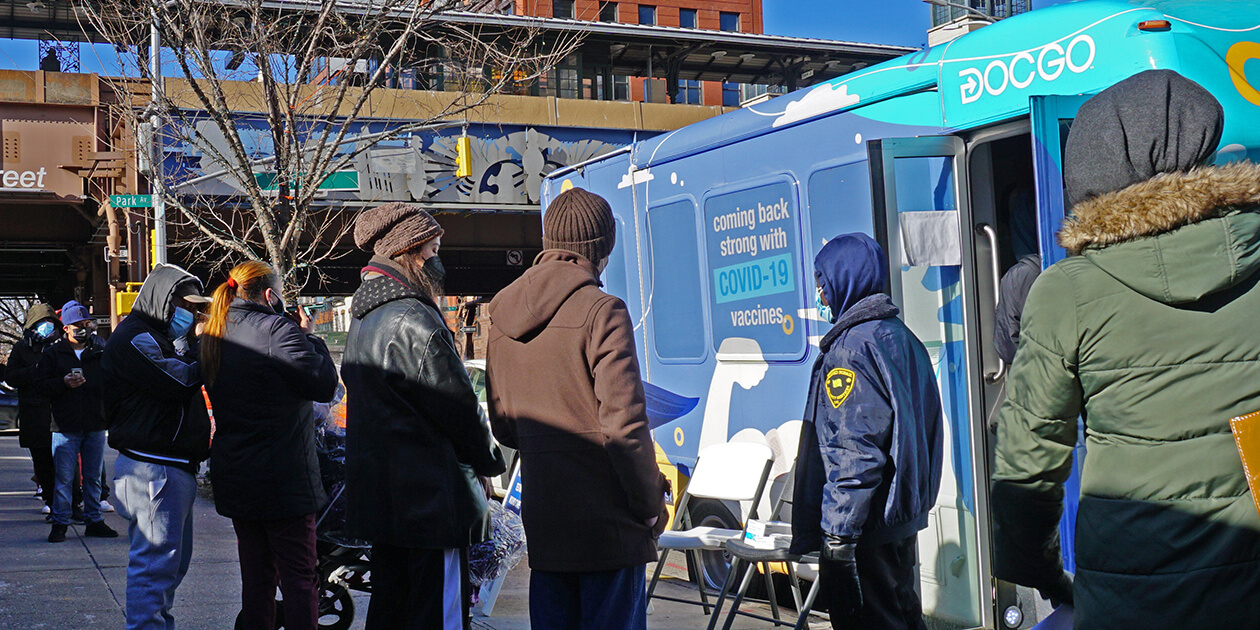Telling Vaccine Stories: NYC CEAL
#Vax4Community Campaign Uses Videos to Overcome Vaccine Hesitancy
Many of Joseph Maria’s neighbors on the Lower East Side of Manhattan worry about having enough food and getting health care when they need it. The pandemic, he explained in a recent video, made things worse. As part of a campaign to encourage people to get the COVID-19 vaccine, he told a story of taking care of his neighborhood—and overcoming his fear of vaccination.

The video is one of a dozen produced by community members for the #Vax4Community campaign. The campaign enlisted storytellers like Mr. Maria to make the videos. The videos are a central part of #Vax4Community’s efforts to use social media to connect with people with lower incomes who are also from racial and ethnic communities that are disproportionately affected by COVID-19.
The campaign is a collaboration of the New York City Community Engagement Alliance to End COVID-19 Disparities (NYCEAL), New York University RADx-Underserved Populations (RADx-UP), and the NYU-CUNY Prevention Research Center (PRC). The project is co-led by epidemiologist Lorna Thorpe, Ph.D., M.P.H., and her other co-principal investigators of the PRC. Dr. Thorpe is also a principal investigator of RADx-UP and a co-investigator on CEAL. Both RADx-UP and CEAL are NIH programs established to rapidly address the pandemic’s impact on underserved communities.
“The stories resonate. They are very real. They captivate people because they capture what a lot of people are experiencing,” said Dr. Thorpe.
The goal for the campaign’s videos and social media outreach is to inspire more people to get vaccinated, especially people who may not trust health care professionals and researchers. The PRC works with community-based organizations to put health communications research into practice—including by providing the organizations with effective, relatable content such as Mr. Maria’s video.
“Our community-based partners are looking for credible information to push out all the time because they're combating misinformation and, in some instances, disinformation,” said Dr. Thorpe.
Building the Campaign
RADx-UP is an NIH-funded initiative that focuses on strategies to increase COVID-19 testing and access to testing in underserved, hard-hit communities. The initiative supports supplements to individual NIH awards. NYCEAL works closely with these communities, focusing on vaccine acceptance and uptake.
Dr. Thorpe’s own research is focused on addressing health inequities in low-income communities. When the pandemic hit, she and her team sought to improve COVID-19 testing in New York City’s 500,000 public housing residents. “That's the size of a small city, like Boston or Miami,” Dr. Thorpe said.
When vaccines became available, it made sense to her to pivot to overcoming vaccine hesitancy. An effective way to do that is to have credible messengers share their experiences.

To help community members tell their stories, the PRC enlisted a storytelling organization. The organization held a series of workshops on storytelling, and the storytellers were paid for their time making the videos.
“This was an incredibly empowering process. It takes several hours of their time. They listen to each other, they create their own stories, and they really love the process,” Dr. Thorpe said. “They feel a tremendous sense of ownership and pride in the videos.”
Armed with videos and social media messages, the campaign team created a schedule and released the videos over several months, beginning in January 2022. The campaign continues through June 2022. Every few weeks, Dr. Thorpe said, the PRC team reviews how well they are engaging members of the community, and they are developing additional ways to disseminate the videos and other campaign materials.
Generating Content
Alessandro Ciari, M.P.H., is the communications manager of PRC. He said the PRC’s role is to generate content that community organizations can use. . “Content and marketing communications,” Mr. Ciari said, “is something that you can't have enough of, especially when you're at the community level and don't necessarily have the capacity or the time to really focus on that type of work.”
PRC provided training for the community organizations on the ground. Outreach staff learned how to share the videos and post on each of their social media platforms. Community organizations can also share the videos through blogs, emails, or any other communications methods that they use.
An outreach campaign is more than just posting videos to Twitter, Mr. Ciari said. The investigators had to create a new operation and assemble a team so that they could produce and post consistently. The biggest lesson they learned, Mr. Ciari said, was to bring in a social media consultant as soon as possible. All of the platforms -- Facebook, Twitter, Instagram, YouTube -- work differently. Best practices vary between them and change over time. Using these channels most efficiently means getting good advice and help from the start.
The team learned many lessons about how to compete with other videos on social media. For example, the videos should engage the audience within the first 3 seconds. Captions help viewers, many of whom don’t have their volume up—they might be watching while riding the subway, for example. High quality imagery and a professional look also help to capture attention.
“The videos are very authentic. They show vulnerability in each one of the participants and show why they were all somewhat hesitant, scared, or resistant to getting the vaccine. And ultimately why they got the vaccine. These are all really amazing stories,” Mr. Ciari said.
Looking Forward
Thorpe and her colleagues at the PRC have gathered considerable data on COVID-19 in the last two years, including how people view many aspects of the pandemic, such as the infection itself, working from home, mental health, and food access. The videos add another dimension to their understanding of how people made their way through the pandemic. “The videos serve as a qualitative complement to a lot of the quantitative data that we have out there,” said Mr. Ciari.
The #Vax4Community campaign includes not only low-income communities, but also south Asian communities and communities of people caught up in the criminal justice system. Those efforts are led by colleagues of Dr. Thorpe’s at the NYU-CUNY PRC.
“So far, we’ve had over a million impressions of all the videos that have been released,” Dr. Thorpe said. “With all the consortia and institutes pushing this out, we hope to have national impact.”
Page updated June 16, 2022
















